Parkinson's Disease Research Lab Supplies, Resources, Software and Links:
The following are links to laboratory resources to help those researching Parkinson's disease.
Alpha-Synuclein Models:
Initiating Parkinson's alpha synuclein aggregation of pre-formed fibrils in animal models or just testing in-vitro, will require one of these products.
- StressMarq Biosciences: Alpha Synuclein Pre-formed Fibrils and Monomers
StressMarq manufactures active proteins and antibodies for PD research. This includes active alpha synuclein pre-formed fibrils (PFFs) that can induce endogenous alpha synuclein phosphorylation and Lewy body formation in neuronal cell culture or for in vitro oligomerization studies. These fibrils seed the formation of new fibrils from active alpha synuclein monomers. Stabilized oligomers are also available, and can induce toxicity in cell models. Also available: A53T mutation Alpha-Synuclein monomers and PFFs (A53T refers to an alpha-synuclein genetic variation in which the 53rd amino acid is changed from Alanine to Threonine). Support products for Alpha-Synuclein protocols.
Distributors: - rPeptide: Alpha Synuclein Preformed Fibrils
These preformed fibrils of α-synuclein may be used as a model for the pathogenic form of α-synuclein in numerous neuropathies. Sourced from E. coli, α-synuclein fibrils were prepared and confirmed by thioflavin assay and electron microscopy.
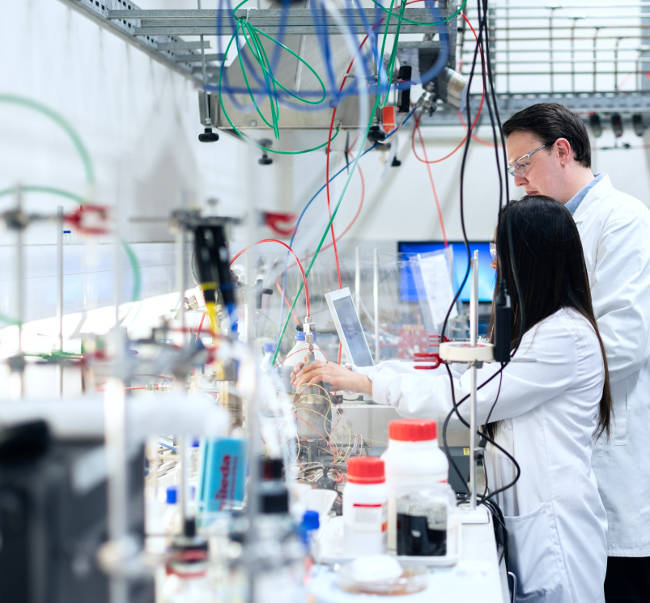
Mouse Models:
Mice used in research are typically genetically modified to express a mutation being studied or to possess a portion of a human DNA sequence in order to react with a human response. After all, the purpose of genetic modification is to develop therapies for humans and not mice. Animals which possess the native and foreign DNA sequences are termed "transgenic".
- Priken BRC: Experimental Animal Division - transgenic mouse models for human disease - Japan
- Scripts - mouse mutants and pathogen free controls
- The Jackson Laboratory - uses CRISPR/Cas9 technology for mouse model development
Parkinson's specific mouse models - Biocytogen - gene editing, animal and cell models
- Taconic - gene editing, knockout, knock-in, transgenic
Parkinson's specific mouse models - Genoway - mutations targeted for Parkinson's and neuroscience research

Inducing Parkinson's Pathology in Mouse Models:
Once a mouse model has been chosen, Parkinson's can be induced with the neurotoxin MPTP or by the injection of human alpha-synuclein pre-formed fibrils (PFF) to seed aggregation of rat alpha-synuclein proteins. Once seeded, propagation of protein aggregates spread along axons.
- Generation of Alpha-Synuclein Preformed Fibrils from Monomers and Use In Vivo (2019)
JoVE.com has various biotech laboratory tutorials and videos including this one on a step-by-step approach to generate an in-vivo alpha-synuclein preformed fibril (α-syn PFF) model of synucleinopathy. - Exogenous α-Synuclein Fibrils Induce Lewy Body Pathology Leading to Synaptic Dysfunction and Neuron Death - (Volpicell-Daley et al., Neuron vol 72, 2011)
Also see Testing movement disorders in mice
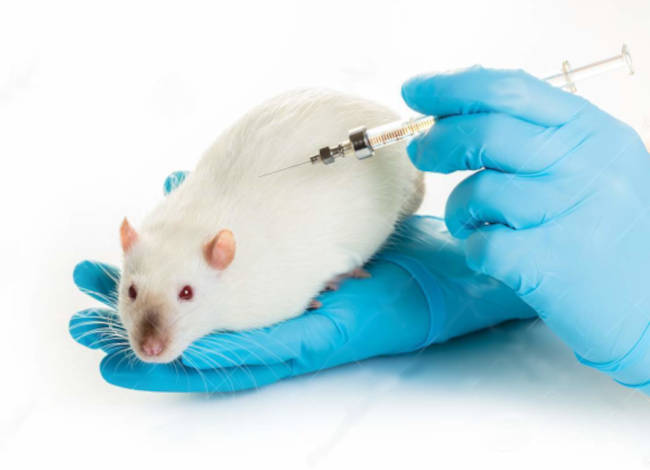
Software Models and Resources:
Gone are the days of counting cells in an image. We have software to do that mundane work. Tinker toy chemical models have been replaced by 3D computer models. Even analytics are automated with purpose built data analysis tools.
- Google AlphaFold - pairing DeepMind AI and protein folding
- AlphaFold Protein Structure Database (EMBL-EBI)
- Fold.it - visual protein folding software for protein research and design
- RCSB: Protein Data Bank (PDB) - hosted by Rutgers, UC San Diego, UC San Diego Supercomputer Center, UC San Francisco
- Human Protein Atlas
- NIH: Chemical structures database (chemical and molecular models including nucleotides, carbohydrates, lipids, peptides, chemically-modified macromolecules, etc)
- National Institute of Health (NIH) software: (free open source)
- ImageJ - Image processing and analysis in Java - microglia item count and astrocytes densities
- Zeiss: software:
- Axiovision - image analysis
- ZEN lite - image acquisition from microscope cameras, image processing and analysis
- GraphPad:
Prism - analysis and graphing solution purpose-built for scientific research - Certara:
Phoenix WinNonlin - data processing, graphing and charting, report generation. Pharmacokinetic/pharmacodynamic (PK/PD), and toxicokinetic (TK) modeling. - CADD: Computer Aided Drug Design
- Schrodinger - computational chemistry, molecular design, drug formulation and visualization
Often teams with pharma drug development programs. - Wavefun: Spartan - computational chemistry and visualization
- Biovia (Dassault Systemes):
Biovia Discovery Studio - biological and physicochemical 3D modeling and simulation. - Cressset
- Pharmacelera
- OpenEye Scientific
- Chemical Computer Group
- Acellera
- Schrodinger - computational chemistry, molecular design, drug formulation and visualization
- SDF: Structure Data Format - text based chemical structure data file
Software which can read SDF files:- Avogadro - free open source for MS/Win, Mac and Linux. Define, model and visualize 3D molecules. Interfaces with many computational chemistry tools
- DataWarrior - free open source
- OpenEye Scientific VIDA
- iMol - free open source
- Jmol - free open source Java based viewer for 3D chemical structures, vibration frequency mode animations, etc
- IQmol - free open source. MS/Win, Mac, Linux. Generate models of molecules.
- Molekel - free open source
- ChemSpotlight - free open source
- Open Babel - free open source
- SDFReader - free open source
- Computational Chemistry Tools:
- Gaussian - molecular mechanics, quantum chemistry, coupled cluster calculations
- ORCA - quantum chemistry, coupled cluster calculations
- Swiss-Model - 3D protein modeling
works with other tools:- Blast - compares protein sequences to sequence databases
- HHBlits - iterative protein sequence searching
- MolProbity - validation for 3D structures of proteins
- HPEPDOCK - predict complex structure between a protein and a peptide
[server] - HDOCK server - Protein-protein and protein-DNA/RNA docking
- MOPAC: Molecular Orbital PACkage - semiempirical quantum chemistry - free open source for MS/Win, Mac and Linux
- GAMESS: General Atomic and Molecular Electronic Structure System - quantum chemical calculations. Many code forks exist with huge differences. Free open source for MS/Win, Mac and Linux
- VMD: Visual Molecular Dynamics - molecular visualization and animation. Free open source for MS/Win, Mac and Linux. Like Avogadro but more sophisticated
- De Novo Software; FCX Express - raw flow cytometry data (number of cells or particles in a liquide flow) to report charts
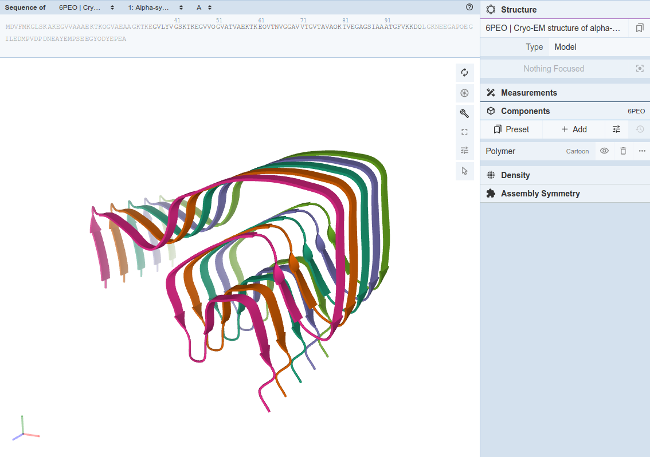
Protein Database: Cryo-EM structure of alpha-synuclein H50Q Narrow Fibril
Statistical Software and Resources:
Statistical software from commercial sources and now more than ever, available as free open source software.
- SAS - statistical analysis
- JAGS: Just Another Gibbs Sampler - GPL program for sequence analysis of Bayesian hierarchical models using Markov Chain Monte Carlo.
- GraphPad: Prism - statistical analysis, linear and nonlinear regression, t-tests, etc
- IBM: SPSS - statistical analysis, data insights
- StatSoft: Statistica - statistical analysis, data preperation

Gibbs statistical sampling
Measurment Equipment:
Data gethering equipment.
- Protein detection/analysis:
- ThermoFisher Scientific:
- ThermoFisher Scientific: imaging systems - Western BLot Analysis (protein detection and quantification)
- hermoFisher Scientific: Reverse Transcription (RT) - enzyme-mediated synthesis of a cDNA from RNA. RT-PCR.
- Applied Biosystems: PCR - Real-Time PCR
- Invitrogen - cellular analysis (staining and counting), molecular biology, protein biology, gene synthesis
- Transmission electron microscop (TEM) - highest-resolution atomic-scale
- ThermoFisher Scientific:
- Signosis - Cytokines ELISA, Gene Expression Analysis, Transcription Factor Assays, ...
- Logos Biosystems - cell counting, cell imaging
- Nexcelon Bioscience - Automated Cell Counters, Image Cytometers, and Reagents
- Cytiva - formerly GE health sciences. filtration, imaging, microscopes, Chromatography, Electrophoresis, etc
- Cytiva: Biacore 8k - measure the binding of antibody to monomeric α-synuclein, single cycle kinetics
- Phenomenex - High Performance Liquid Chromatography (HPLC)
- Agilent - test, analysis, bio, electrical, etc
- BioTek - imaging and microscopy, spectrophotometers (protein quantificcation), robotics, ...
- Bruker - mass spectrometry
- Zeiss - microscopy, electron, x-ray, optical, ...
- ProteinSimple - protein imaging, measurement, identification, ELISA, purification, ...
- Sysmex: CyFlow Cube 6 - Flow cytometer. Uses lasers to detect particles in liquide flow.
- Brain Products - hardware and software solutions for neurophysiological research: electrode caps, eye trackers, 3D acceleration sensors (MRI compatable) for measuring tremors.
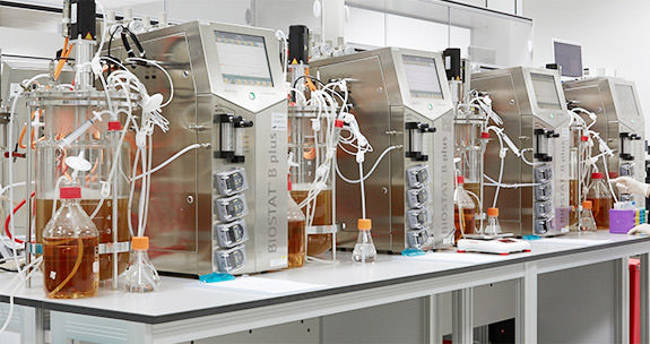
Lab Equipment and Chemicals:
General suppliers of biological research equipment.
- Bio-Rad - digital biology, genomics, diagnostics, cell biology, lab equipment and supplies
- Millipore SiGMa - lab supplies, EIA kits, substrates, ...
- Vector Laboratories - reagents, immunofluorescence, staining, detection, etc
- Phoenix Pharmaceuticals Inc - peptides, assay kits, EIA kits, etc. Exendin-4 (Heloderma suspectum) EIA Ki (measurement).
- Qiagen - RNA isolation kits, DNA methylation analysis, RNA/DNA sequencing, etc
- Abcam - Assay kits, reagents and antibodies.
LDH Assay Kit - Cell death/Cytotoxicity - detection of LDH released from damaged cells used to assess the level of plasma membrane damage in a cell population - Tocris - reagents
- Takara - reagents for cloning, DNA ligation kits

Stains:
Positive staining and fluorescent tagging are used to visualize and identify the entity of interest (cell type, organelles, etc). Stains can have chemical affinity, a chemical reaction, immunization marker, bind to a protein, etc Negative staining has the opposite effect, to highlight everything but the entity of interest, thus making the entity of interest identifiable. Staining can also be categorized as "simple" or "differential" where simple staining uses one type of stain at a time while differential staining uses multiple stains where different entity types appear in different colors. The method of staining will also be influenced by the type of microscopy used (optical, electron) as well as the frequency and wavelength of light.
Also see:- Wikipedia: staining (general overview).
- A novel panel of α-synuclein antibodies reveal distinctive staining profiles in synucleinopathies (2017)
- Detect low-abundance proteins with biotinylated antibodies - discussion of Labeled Streptavidin-Biotinylated (LSAB) antibody detection method of signal amplification to improve sensitivity.
- Agilent: anti-GFAP - Microglia and astrocytes from the SNpc region
- FujiFilm/Wako Chemicals: anti-Iba-1 - Microglia and astrocytes from the SNpc region
- ThermoFisher: alamarBlue - Cell Viability Reagent, DA neuronal cell death
- Nexcelon: Trypan Blue - identification and enumeration of live (unstained) and dead (blue) cells in a given population
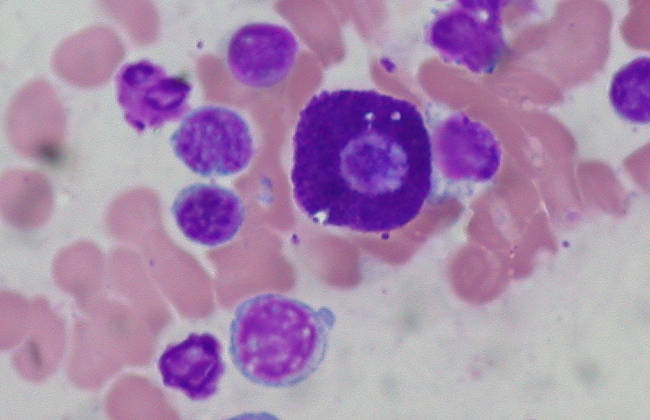
Stem cells:
- WiCell Research Institute - Madison WI
- ATCC: American Type Culture Collection - Human neuroblastoma cell line
- Clone Express - Neuronal progenitor cells (hNPC)
- ScienCell - neurons and cell culture media
- Tactonic - mouse models/parts/embrionic brains
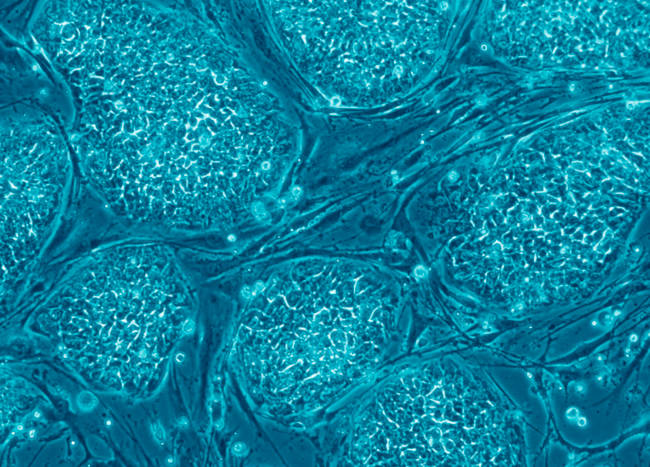
Antibodies:
- BD Bioscience - alpha-synuclein
- Biolegend - Antibodies, Proteins, Kits, Proteogenomics, reagents. p-alpha-synuclein, Tuj1
Biotin anti-α-Synuclein, 103-108 Antibody - Abcam - Assay kits, reagents and antibodies. p-alpha-synuclein, C31, C1q, IL-1a, TMEM119, IgG
- Millipore SiGMa - lab supplies, EIA kits, substrates, ... Dopamine transporter (DAT), β-actin-HRP, GFAP
- R&D Systems - proteins, antibodies, ELISA kits, laboratory reagents, and tools. C3d
- Novus Biologicals - Antibodies, Kits, Proteins, ... Tyrosine Hydroxylase
- Agilent: Dako - Antibodies. GFAP
- FujiFilm: Waco Chemicals - e-Reagent. antibodies, Iba-1
- Santa Cruz Biotechnology - GLP-1R, Lamin A/C
- Cell Signaling Technology - Antibodies and Reagents. TNFa, NF-kB P65, p-NF-kB p65, a-tubulin
- Quidel - antigen tests, immunoassays, antibodies. C1q
- BiosPacific - antibodies and antigens
- Southern Biotech - primary and secondary antibodies (IgG for use with ELISA).
- Mabtech - development and generation of antibodies and assays for understanding immune respopnse (ELISpot, FluoroSpot, and FociSpot).
- Lonza - development and generation of antibodies ant therapies
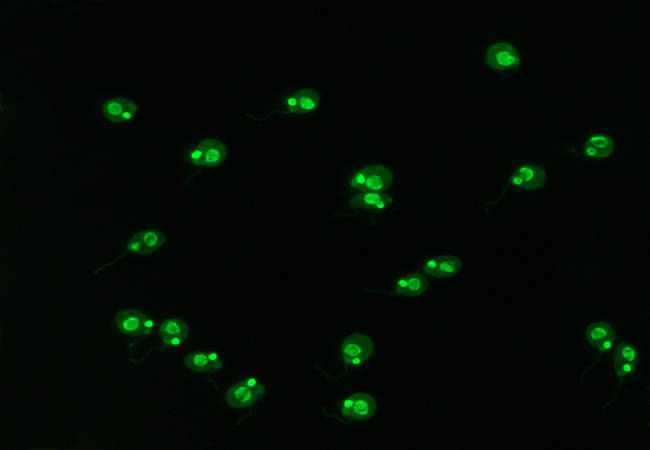
Links:
- National Health and Nutrition Examination Survey (NHANES) MEC Laboratory Procedures Manual - PDF CDC 2020
Collection, processing, storage, and shipping of blood, urine, and other biological and environmental specimens. Collectively, these specimens provide data about the health status of the U.S. population.
Lab Terms and Acronyms:
| Term or Acronym | Description |
|---|---|
| ELISA | Enzyme Linked Immunosorbent Assay: analytical measurement method that uses antibodies to detect the presence of peptides, proteins, antigens or hormones |
| EIA | Enzyme Immunoassay: used to detect antigens or antibodies by producing an enzyme triggered color change. Often used interchangably with the acronym ELISA |
| assay | An assay is a lab procedure to measure the presece or amount of an entity (drug, biochemical substance, cell, ...) |
| antigen | An antigen is a molecule, present on the outside of a pathogen, that can be bound by an antigen-specific antibody. Antigens typically trigger an immune response |
| antibody | An antibody is a Y shaped protein used to identify and neutralize pathogens (bacteria and viruses). The antibody recognizes the antigen which identifies the pathogen |
| substrate | The chemical being observed in a chemical reaction |
| reagent | The substance added to a system to cause a chemical reaction |
| ESC | embryonic stem cells |
| PBS | phosphate buffered saline |
| Tg | Transgenic: lab animals with some of their DNA substituted with human DNA to better model drug efficacy for human consumption |
| immunofluorescence | is an assay which is used primarily on biological samples and used to detect antigens using specific antibodies |
| immunoblotting | (western blotting) is an assay using antigen-antibody interaction for the detection and characterization of specific proteins |